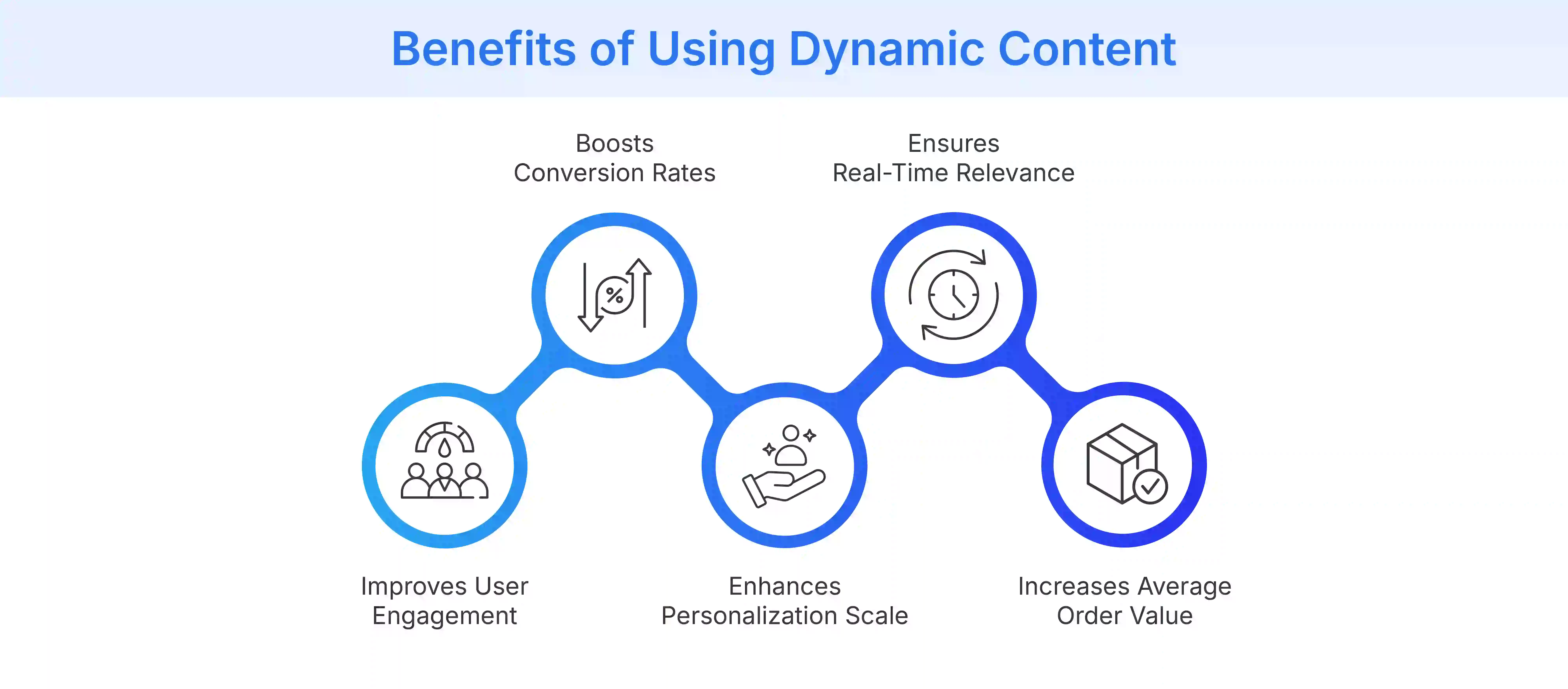Table of Contents
- What is Dynamic Content and Why is it Important in Ecommerce?
- What Are the Benefits of Using Dynamic Content?
- Examples of Dynamic Content
- What Are the Different Types of Dynamic Content?
- What Are the Key Challenges in Using Dynamic Content?
- What Are Some Best Practices for Using Dynamic Content?
- Conclusion
What is Dynamic Content and Why is it Important in Marketing?
Dynamic content in ecommerce refers to on-site elements that automatically update based on individual user data, such as browsing behavior, purchase history, or present context. Unlike static content, which stays the same for all site visitors, dynamic content adapts to each customer, making their buyer's journey more relevant and efficient.
By using a dynamic content strategy, e-commerce retailers can customize landing page elements, product listings, email content, and even shopping cart experiences in real time. This results in meaningful customer engagement and higher conversion rates.
Its purpose in enhancing user experience and personalization includes:
- Tailoring homepage banners to returning customers’ interests.
- Displaying related products based on viewing history.
- Adjusting pricing or promotions for specific customer segments.
- Showing relevant cross-sells or upsells during checkout.
- Personalizing email marketing campaigns based on past purchases..
What Are the Benefits of Using Dynamic Content?
Implementing dynamic content offers significant advantages for ecommerce retailers looking to optimize online performance.
- Improves User Engagement: Tailoring website elements, such as banners or product displays, captures visitor attention more effectively. This relevance encourages users to spend more time exploring the site content.
- Boosts Conversion Rates: Presenting personalized recommendations or targeted promotions guides users towards purchase decisions at the right time. Adaptive content reduces friction by displaying items that customers are likely to purchase.
- Enhances Personalization Scale: Retailers can deliver unique experiences to large numbers of individual shoppers automatically. This level of personalization was previously challenging to achieve efficiently.
- Ensures Real-Time Relevance: Content updates instantly in response to current data, such as stock levels or pricing changes. This ensures customers see accurate information and current offers.
- Increases Average Order Value: Showing complementary products or bundles based on items in the cart encourages customers to add more. This strategy leverages user signals during their session.

Examples of Dynamic Content
Dynamic content transforms standard e-commerce experiences into personalized journeys that respond intelligently to each customer’s unique context and behavioral data patterns. Here are some examples that show dynamic content in action:
- Homepage Hero Banners: An online clothing retailer displays different homepage banners based on visitor behavior. For instance, showing women’s summer collections to female customers who previously browsed warm-weather apparel, while presenting men’s business attire to those who viewed formal wear categories.
- Product Recommendation Carousels: An electronics e-commerce site implements ‘Frequently Bought Together’ and ‘You May Also Like’ sections that dynamically adjust based on the current product being viewed and the customer’s browsing history. This significantly increases the average order value through complementary product discovery.
- Checkout Page Upsells: During the checkout process, a beauty products retailer dynamically generates limited-time offers for travel-sized versions of products in the customer’s cart. This is accompanied with messaging that changes based on cart value, purchase history, and membership status to maximize conversion opportunity.
What Are the Different Types of Dynamic Content?
Various forms of dynamic content are employed in ecommerce to enhance customer experiences. Each type serves distinct functions based on the data or user interaction involved.
Personalized Content
This type tailors content based on a user's individual profile, Browse history, purchase behavior, or demographics. It ensures that product recommendations, offers, or even site layouts feel uniquely relevant to that specific shopper.
Contextual Content
Contextual content adapts according to the user's current situation or environment. Factors like geographic location, device type (mobile vs. desktop), traffic source, or even the time of day trigger changes to the displayed information or promotions.
Interactive Content
Interactive dynamic content actively involves the user, making the experience more engaging. Quizzes guiding product selection, calculators for payment plans, or surveys collecting preferences are examples that adapt based on user input.
Real-Time Content
This content changes instantly based on current, live data streams or immediate user actions. Showing accurate stock availability, displaying countdown timers for flash sales, or updating pricing based on demand are critical for timely ecommerce decisions. This is where a wealth of customer data becomes invaluable.
What Are the Key Challenges in Using Dynamic Content?
While powerful, implementing dynamic content in ecommerce presents several hurdles that retailers must address. Overcoming these challenges is crucial for successful personalization strategies across marketing channels.
- Technical Complexity: Integrating data sources and ensuring different site elements change smoothly requires significant technical expertise. Platforms must handle real-time data processing efficiently.
- Data Management & Privacy: Collecting, storing, and processing customer data ethically and securely is paramount. Ensuring compliance with privacy regulations adds another layer of complexity.
- Content Creation Effort: Developing multiple variations of content for different segments can be time-consuming. Retailers need robust content management workflows to keep everything organized.
- Real-Time Data Accuracy: Relying on instant data requires reliable systems to avoid displaying incorrect information. Maintaining data accuracy across different platforms is vital.

What Are Some Best Practices for Using Dynamic Content?
To maximize the impact of dynamic content in an ecommerce store, retailers should follow proven strategies to ensure that the content is effective and delivers a positive user experience:
- Align Content with User Intent: Understand what visitors are trying to achieve on the site and tailor dynamic elements accordingly. Presenting relevant information or products matches their immediate goals effectively.
- Prioritize Fast Load Times: Ensure that dynamic elements load quickly without slowing down page speed. Slow-loading content frustrates users and negatively impacts conversion rates in ecommerce.
- Continuously Test and Optimize: Implement A/B testing for different dynamic content variations to see what resonates best. Regularly analyze performance data to refine personalization rules and content.
- Maintain Design Consistency: Ensure dynamic content seamlessly integrates with the overall website design and branding. Inconsistent visuals can create a jarring experience for the shopper.
- Utilize High-Quality, Accurate Data: The effectiveness of dynamic content relies heavily on precise customer data. Ensure data is clean, relevant, and updated frequently for meaningful personalization.
Conclusion
Dynamic content stands as a fundamental tool in the modern data-driven ecommerce landscape. It empowers retailers to move beyond generic experiences and offer scalable personalization to each visitor.
By adapting based on user data and context, this content drives deeper engagement and significantly improves key performance indicators like conversion rates. Embracing dynamic content allows ecommerce businesses to build stronger customer relationships and remain competitive in a crowded digital marketplace.
FAQ
Yes, if not optimized correctly, loading multiple dynamic content elements can potentially slow down page speed. Efficient implementation and server-side processing are crucial for maintaining fast load times on an ecommerce site and ensuring a smooth user experience.
While adaptable, dynamic content is most impactful for sites where personalization significantly enhances the user journey, such as ecommerce stores with diverse products and audiences. Its complexity might be less beneficial for very simple, static informational pages.
Dynamic content utilizes customer data like Browse history, purchase records, demographics, and location to trigger content variations. This data allows an ecommerce platform to automatically display the most relevant products, offers, or messages to an individual user.
Many marketing automation platforms, advanced Content Management Systems (CMS), and specialized personalization software solutions offer features for creating and managing dynamic content. These tools often integrate with ecommerce platforms to access necessary customer data.

